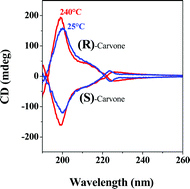Processing conditions for the specific δ-form syndiotactic polystyrene (s-PS) films, being suitable to detect amplify and memorize the chirality of several volatile non-racemic organic guests, have been investigated. The occurrence of induced circular dichroism (ICD) phenomena is critically dependent not only on the presence of the nanoporous δ phase but also on the solvent and process used for the film preparation. The dependence of the ICD phenomena on the guest enantiomeric excess has also been studied. The observed ICD phenomena, and hence the memory of the non-racemic guest molecules, remain stable not only after chiral-guest removal but also after thermal treatments up to the polymer melting temperature (≈270 °C). In particular, the maintenance of intense ICD phenomena also after the thermal transition toward the trans-planar α crystalline phase indicates that the chiral memory is not associated with some molecular structure but with the formation of non-racemic supramolecular structures. These supramolecular structures could be possibly associated with the large rod-like crystallites observed only for δ-form s-PS chiral-sensing films (by atomic force microscopy). In fact, these crystallites are clearly re-crystallized, as a consequence of guest sorption, and then remain essentially unaltered for thermal treatments, at least up to 240 °C.

You have access to this article
 Please wait while we load your content...
Something went wrong. Try again?
Please wait while we load your content...
Something went wrong. Try again?


 Please wait while we load your content...
Please wait while we load your content...